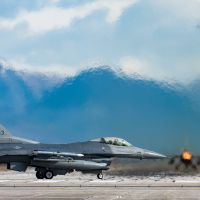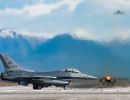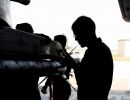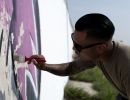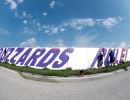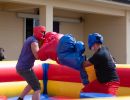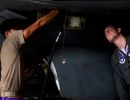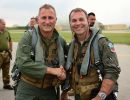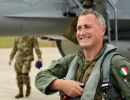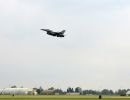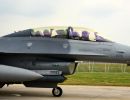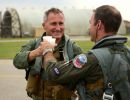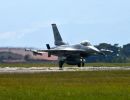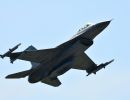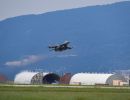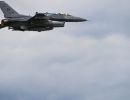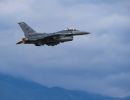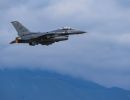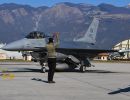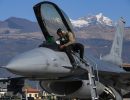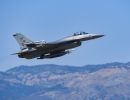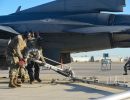The 405th Group, with three tactical squadrons 509th, 510th, 511th originated at a typical cantonment-type airbase in the pine and cotton country of the South Carolina Piedmont. Fighter pilots came from Sarasota, Drew, Pinellas, Tallahassee, Bartow, Ft. Myers and Thomasville. Among them were squadron commanders, operations officers and flight commanders. Many had been training replacement pilots, for units already in combat, and had logged hundreds of hours in P-40 and P-39 aircraft.
During our three months at Walterboro we flew the P-39 and P-47. At Orlando, Florida, in order to get ready for forward operating bases, we maneuvered into some pretty primitive stateside facsimiles. Also, we were introduced to jeeps, mess kits and pyramidal tents.
Fighter pilots, MOS 1055, especially lieutenants, as I was, are not especially versed in the niceties of organization and logistics. So, where did the rest of the squadron come from?
Already in place when we arrived was a super team of aircraft mechanics, armorers, bomb handlers, radio technicians, refuelers, drivers, intelligence specialists, supply and food service specialists, administrators, group of great non-rated officers, and a very special flight surgeon. This part of the team would remain until war's end, while pilots would come and go as the fortune of war dictated.
About mid-February, 1944, the 405th entrained to Camp Shanks, N.Y. for overseas processing. We would receive aircraft in England. It took ten days to two weeks to dry run abandon-ship procedures, get shots, gas masks and helmets, but we all had a chance to visit the Big Apple wearing our pinks and greens before they hit the bottom of a duffle bag.
Finally on February 29th, we boarded the Cunard White Star Liner Mauretania, converted to troop transport, and sailed without escort. The first day at sea was fine. Two meals a day were served in remarkable style in the dining salon. A winter storm set in on the second day, continuing until the British Isles came into view, and seasickness was the order of the day. I was provost marshal on the trip with 400 assigned from the passenger roster. Since those on guard duty were not immune, I can only surmise that a conscientious trooper, who would quit his post only when properly relieved, may still be on board.
We docked in Liverpool, marching down the gangplank with gas masks and helmets ready. Hoardes of children accosted us, hitting us up for gum and chocolate. The little buggers were away from their shelters without survival gear. What kind of war was this?
Shortly we arrived at Christchurch, near Bournemouth on the south coast across the channel from Normandy. A single runway, of marginal length for a heavily loaded P-47, was surfaced with wire square mesh and shared with a Horsa Glider factory. We were billeted in cottages across the runway from group headquarters housed in a huge mansion. Most pilots soon acquired, through purchase, an English bicycle to replace the convertibles left behind. I mention "purchase", since acquisition was handled quite differently on the continent.
The first combat missions, as I recall, were under the tutelage of a P-47 group that had seen earlier action. Then we started to fly at group strength over France on missions called fighter sweeps. 88mm flak would darken the nearby sky, but its effectiveness was not impressive. Holding formation when climbing or descending through overcast was of more concern. I don't recall the 405th having trouble with this.
There were missions flown against crossbow targets, which were buzz bomb launching sites along the French coast. We also flew escort for 8th Air Force B-17 and B-24 bombers.
In due time we were introduced to the type of mission that would be our specialty-armed reconnaissance. For the remainder of the war we would do interdiction, close support and isolation of the battle field. Call it what you will, it involved dropping 500 pound bombs with a release point calculated to provide sufficient altitude for recovery from the dive and avoiding collision with the target. After bomb release, we would strafe with the fire from our eight 50 caliber machine guns. These guns were harmonized for 250 yards, so again the attack had to be pressed to the point of near collision for best effect.
I recall an early mission at group strength, southwest of Avranches, when a train was sighted by all three squadrons at once. the congestion of attacking P-47s over the locomotive would have struck fear in the modern day Thunderbird demonstration team. That no mid-air collisions resulted was a miracle in itself.
It was apparent that squadrons must be assigned areas where targets of opportunity could be acquired and attacked, without the risk of other squadrons simultaneously bombing or strafing the same target. The 509th or 511th could work further down the road or rail line, or in the same area at a different time.
This then became the technique that proved so devastating to German armies in the field. During daylight hours, vehicular supply columns and trains simply could not operate without being savagely attacked by Tactical Air Command's fighter bombers. The squadron would fly parallel to highway or railroad at about 5,000 feet. Upon sighting a target, a split S maneuver would put the Thunderbolt in a near-vertical dive toward the tank, locomotive, or truck column. Bomb release and recovery had to be simultaneous. Then a gunnery pattern would be established to attack with machine gun fire, the pilot making repeated strafing runs while always keeping his eyes on the target, literally flying by the seat of his pants. Skip bombing with 500 pounders or napalm was effective if the target had vertical dimension, such as a headquarters building, railroad roundhouse or marshaling yard. While safer, dive bombing from higher altitude, say 10,000 feet, would introduce higher speed, heavy torque and the need to start recovery from higher altitude with considerable loss of accuracy.
On 19 May, 1944 IX Tactical Air Command awarded the first decorations to pilots of the 510th. Air medals went to Parcell, Jenkins, Blood, Curran, Johnston, Leinweber, Alverson, Boucher, Hamilton, James, Kociencki, Mohrle, Shelton and Sparkman. Also included was operations officer Captain William B. Taylor, who was missing in action.
In preparation for D-Day and the invasion of France, our missions were increasingly directed to transport in the area south of what would become Utah and Omaha beaches. On 6 June 1944 it happened. All night C-47 aircraft, loaded with paratroopers and towing troop-laden gliders, flew over Christchurch heading for Normandy. At dawn, pilots of the 510th flying their first mission of the day, looked down on the greatest invasion fleet in history.
Reacting to the landings in France, a tremendous movement of German men and material started toward the beaches, including Tiger and Panther tanks of Panzer divisions. An armored division put up a withering barrage of 20mm and 40mm cannon fire; a horse drawn artillery unit practically none. Streams of flak came up from a Luftwaffe base, while most supply trains put up very little. Therefore, to a considerable extent, loss rates of fighter-bombers could be correlated with target selection in an environment where targets were many and varied.
Losses increased dramatically. Operations continued from the UK and it would be several weeks after D-Day until forward operating bases were built by our engineers. Many P-47s recrossed the channel with a cylinder shot away, the fuselage bathed in engine oil, the canopy open after being blackened when a gasoline or ammunition truck blew up as the pilot pulled up from a strafing run. Of course some were hit so severely that they crashed with their airplanes while others regained enough altitude to effect bailout.
The love affair between a pilot and his Thunderbolt was irresistible, considering the fact many sustained some degree of battle damage at least fifty percent of the time over a tour of duty totaling as many as 90 missions.
In July the 405th moved to St. Mere Eglise on a strip called A-8. It was a true operating base, carved out of an apple orchard, surfaced with tar paper and shared with Royal Air Force Mosquito night fighters. Artillery fire could be heard, flight time to our targets was measured in minutes, we had to circle to gain the necessary 10,000 to 12,000 feet for crossing the front.
I believe it was 29 July 1944 that Operation Cobra took place. In an area south of the road between Periers and Lessay, a devastating bombardment took place by 8th AF B-17s and B-24s with 9th AF B-26s blasting a hole in the German lines permitting General Patton's 3rd Army to break out of the beach head. It was called the St. Lo Breakthrough.
Early the next morning, as the fog began to burn off, the 510th was airborne to reconnoiter the road leading south to Avranches. A thin cloud layer dissipated and there, 5,000 feet below us, was a column of German vehicles stretching for miles, bumper to bumper in a grand retreat. XIX TAC was informed by radio and the attack was on. By day's end, the 405th would be credited with the destruction of 440 vehicles. It is doubtful that any escaped. Armored troops and motorized artillery men were reduced to walking infantry, if they could walk at all.
Patton's troops, pouring through the gap, moved southward then eastward. His right flank, along the Loire river, was protected by P-47 fighter bombers. German efforts to hold and counterattack ended in debacles at Falaise and Argentan, where entire German armies were trapped and caused to surrender. Again, P-47s ranging far ahead of advancing troops could confirm that nothing was there to impede a lightening advance and Patton, in a matter of days, moved beyond Paris to the area of Nancy and Metz along the Mossel river.
During the Normandy breakout, the situation was so fluid that Allied vehicles showed orange panels to alert our pilots to friendly forces while our planes carried invasion stripes-wide bands of white paint on the wings, so errors of inadvertence were minimized. The Luftwaffe scarcely showed itself, having lost control of the air over the battlefield.
About this time, it seemed clear that defacto victory was at hand. The German army was unable to drive us back to the sea and could neither bring up reinforcements nor conduct an orderly retreat. The German navy sat out the invasion and the Luftwaffe had little more than nuisance value. Allied bombers made 1,000 plane raids at will. When we saw for ourselves what, since 1942, the 8th AF had been doing in daylight and the Royal Air Force bombers had done at night, it became incomprehensible that Hitler would continue to fight.
When the 510th lost a plane, it was replaced the next day. A replacement pilot arrived the day after one went down. We were never short of bombs, ammunition or fuel. Contrast this with the Luftwaffe: all aircraft factories were subject to bombardment, training fields were under attack by Allied fighters, fuel trains and trucks were under constant harassment.
But, after the St. Lo breakout, nine more months of fighting ensued before Germany surrendered. The 405th would be scheduled to move forward with the 3rd Army. An advance party would be dispatched, but the front moved so fast that we would leapfrog the programmed base and settle on one further east. Thus, in September, 1944, we moved from St. Mere Eglise to St. Dizier on the Marne River, well east of Paris and not far west of Nancy and Metz. Allied forces were taking up winter positions; it was time to develop the ports and bring up supplies to support a drive into Germany itself. For the 510th most of the pilots who had joined at Walterboro would be finishing their tour of duty and returned home.
Vicious attacks and counter attacks took place during our entire tenure of duty at St. Dizier. Unrelenting pressure was applied to the enemy, but there wouldn't be great movement of ground forces. In a booklet put out by XIX TAC, the 405th and 510th were cited time after time for missions launched from this base. On 17, 18, 19 of November, 1944 fighter bombers destroyed 570 motor vehicles, 141 locomotives and 630 railcars in battles east of Metz. Missions from St. Dizier supported a parachute drop at a bridge at Nimegen.
In December, German General Von Runstedt launched an offensive through the Ardennes to drive to the sea and separate Allied forces. It was their last great effort to gain control. Known as the Battle of the Bulge, it put a place called Bastogne on the map. Using the element of surprise and the cover of bad weather, the Germans did attain early successes. But, as soon as minimum visibility and ceilings existed, the Ninth Air Force's three Tactical Air Command fighter bombers flew savage, unrelenting attacks on German armored columns. The offensive collapsed and the battle ended near Purm on 20 December, 1945. Here 1,179 vehicles of the retreating German army were destroyed. XIX TAC alone flew 2,856 sorties.
Shortly thereafter, the 405th moved north to Belgium at Zwartberg near Liege. The runway, on rather boggy ground, was pierced steel plank. Buzz bombs flew through the traffic pattern toward Antwerp. Now assigned to XXIX TAC we were supporting the IX Army for the Rhine River crossing. The capture of the Ramagen bridge, prior to its demolition and an eminently successful parachute drop north of the Ruhr, put the Germans on the run and the situation again became fluid. We were programmed to move to a field just east of the Ruhr, but before this could be done, the front advanced much further east. We moved to Kitzengen, an old Luftwaffe base, north of Nurnberg.
I believe it was on May 8th that all three 405th squadrons were airborne in a victory flyover when nine German aircraft appeared in our traffic pattern-a mixed bag of ME 109's, Stukas and a trainer or two. Half were deliberately ground looped or nosed up on landing. About 27 people were on board, three per single seat, single engine aircraft, some carried in radio compartments. There were several officers, and some enlisted women of the G.A.F. Not flying at the time, I took the senior officers to my office in a flight line hangar. One was quite senior and wore a Knights Cross with diamonds on a ribbon around his neck. There were, in addition, two lieutenant colonels. They were young, two had wooden legs. All spoke English so the interpreter was dismissed. The senior officer was Hans Rudel, the famous Stuka expert. The others were probably what was left of his staff.
The Germans confirmed that the Luftwaffe was severely hurt by their inability to train more pilots, that there were no safe airbases, that the factories were leveled, that fuel could not be placed where needed. When questioned about the deteriorating quality of their fighter pilots, we hit a raw nerve. One squadron commander challenged any of us to go aloft with an unarmed P-47 and engage him in a mock dog fight in his unarmed ME 109. Our group commander, of course, rejected that proposal.
After two hours of conversation, it was time to turn our "prisoners" over to the provost marshal! Before leaving, Rudel made a curious remark. He said, "We should not have been fighting each other. Our common enemy lay to the east-Russia."
On the 9th of May the war in Europe was over. Perhaps 150 pilots served with the 510th during World War II. It would take a historian armed with all morning reports, casualty reports plus general and special orders to precisely tabulate a recapitulation. But I would surmise that, of this number, about one third was shot down. Of these, a third was killed in action, a third evaded and a third became prisoners of war. Some flew 130 missions or more while others were shot down before completing five missions. Others joined just as the war ended.
What they all had in common was an espirit, elan camaraderie and the will to provide the U.S. Army with the highest degree of close support ever seen on the battlefield. So complete was the Germans' defeat, it seemed about as likely for them to wage offensive warfare any time in the future as it would for Oregon to attack Idaho.
Members of the 510th can stand proudly for their contribution toward peace and security within our most beloved country.

